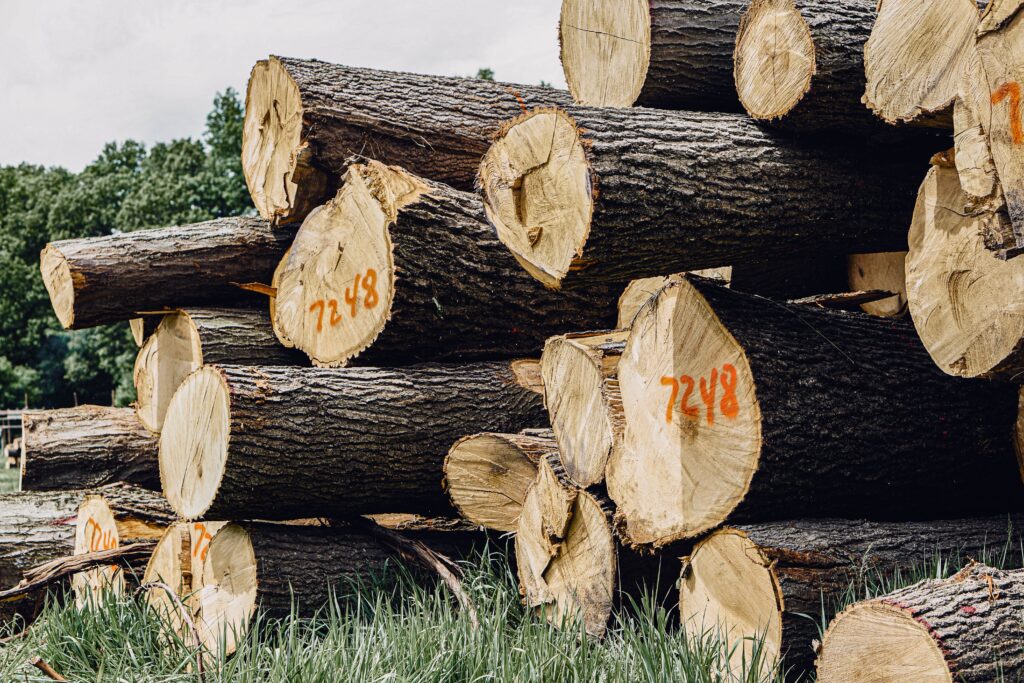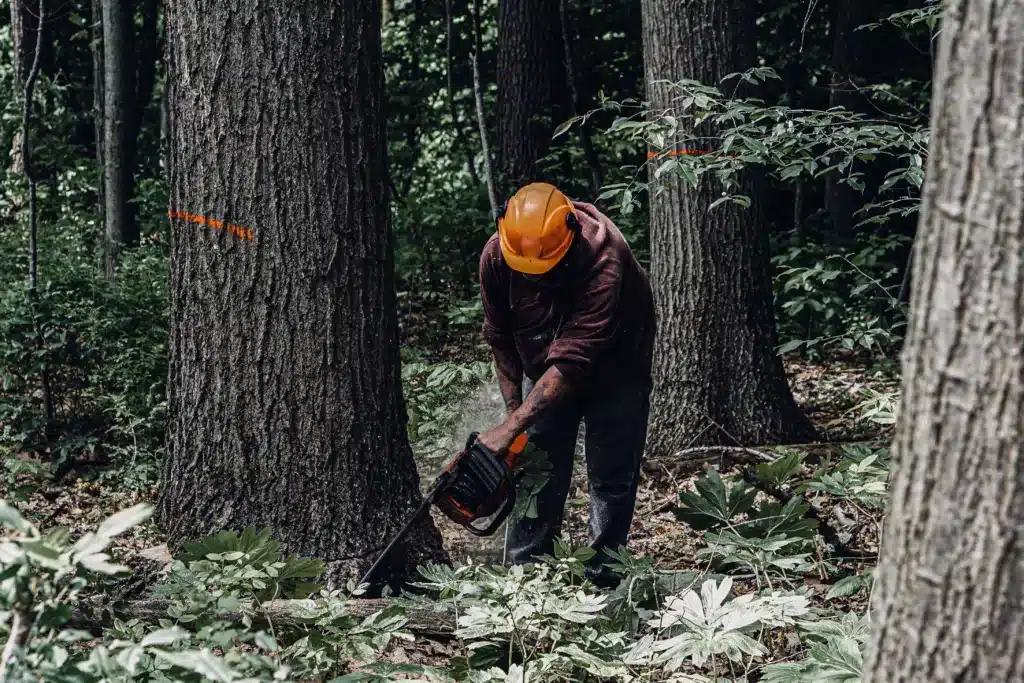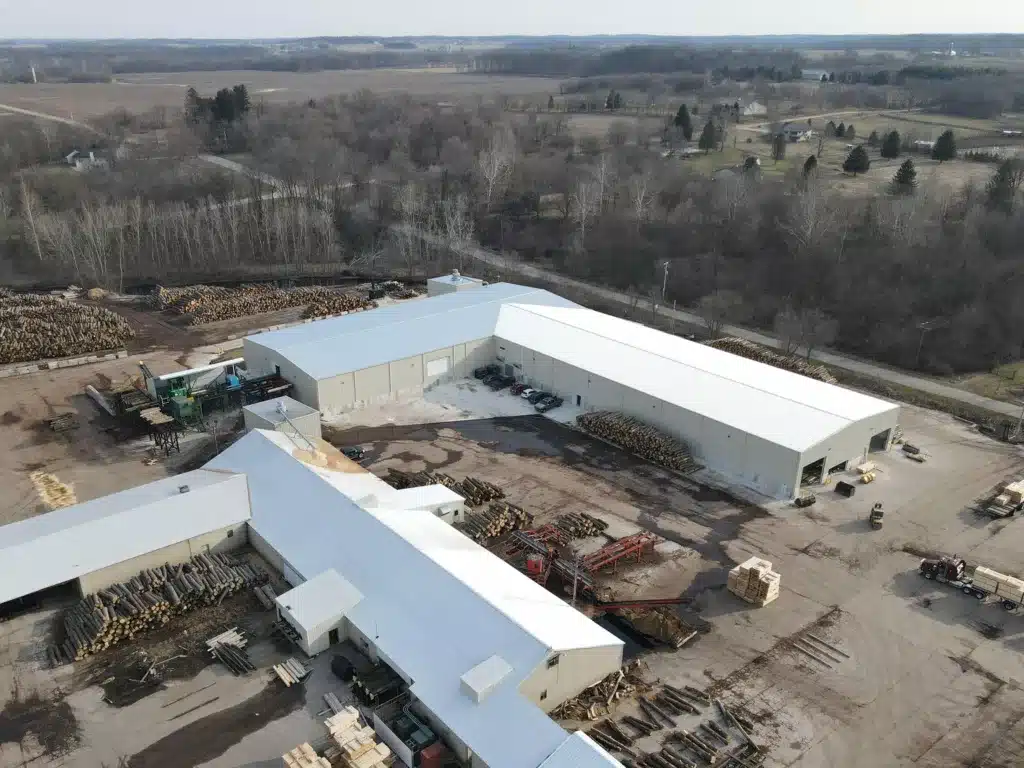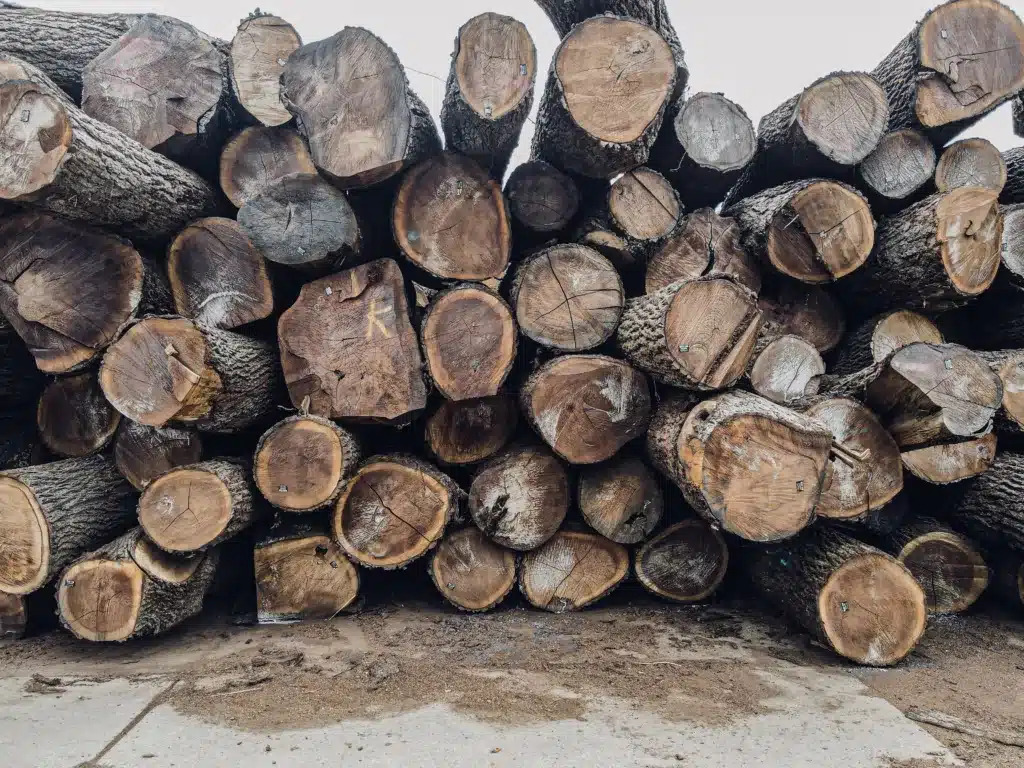Do you know what type of timber you have in your woodlot? And how can you tell the difference between hardwood and softwood? Telling the difference between the trees in your woodlot is simpler than it may seem. And once you can tell the difference, you’ll be able to determine just how much your timber is worth! Selling your standing timber is a great way to profit from your woodlot while maintaining healthy growth cycles.
What is the difference between hardwood and softwood?
Hardwoods and softwoods are distinguished by the tree they come from. Hardwoods derive from angiosperm trees while softwoods come from gymnosperm trees, like conifers.
What are hardwoods?
Hardwoods come from trees classified as angiosperms that reproduce with a flowering plant, like oak, walnut, and maple. Hardwood trees are mostly deciduous, having broad leaves that change color and fall off in the autumn and winter.
The structure of a hardwood is typically more complex than that of a softwood. Typically, they grow more slowly than softwood trees. They can take up to 150 years to be harvest ready. This results in more dense, heavy, and hard-wearing timber.
Hardwood is considered a very versatile material, with uses ranging from veneers and furniture to musical instruments, flooring, construction, and boatbuilding. It’s available in countless combinations of species, specifications, and colors. Because of their condensed and more complex structure, hardwoods generally offer a superior level of strength and durability. It’s because of these desirable qualities that hardwoods command a higher price on the market.
What are softwoods?
Softwoods come from gymnosperm trees, such as conifer (or evergreen) trees. These trees (like pines, cedars, and spruces) have needle-like leaves that usually remain green year-round, as opposed to broad leaves that shed annually.
Softwoods grow faster than hardwoods, usually taking around 40 years to be harvest ready. Its fast-growing nature tends to make them less dense than hardwoods. Softwoods are more readily available and easily manipulated than hardwoods. And because they also develop at a quicker pace, they end up having lower cost levels.
Softwood can be used across a range of internal and external applications – from furniture and flooring to decking, landscaping, and structural applications. They are flexible, lighter in weight, and less dense than most hardwoods.
How You Can Tell the Difference Between Hardwood and Softwood
Hardwoods and softwoods are not necessarily distinguished by their appearance or properties. Their identification instead originates from the tree species. However, its properties can definitely be a good place to start.
Grain
- Hardwoods: heavy, distinctive grain
- Softwoods: softer, less pronounced grain
Color
- Hardwoods: darker in color than softwoods
- Softwoods: lighter in color than hardwoods
Hardness
- Hardwoods: stronger, more scratch-resistant, and harder-wearing
- Softwood: Flexible and may chip easily with a chisel
Weight
- Hardwood: Heavier in weight and denser
- Softwoods: Lighter in weight and less dense

Hardwood vs. Softwood
Hardwood vs. Softwood: Cell Structure
One key difference between hardwoods and softwoods is cell structure. Hardwoods contain tube-like pores (or vessels) that are used for transporting water and nutrients. These pores are what give hardwoods a more prominent, heavier grain compared to softwoods.
Softwoods have a simpler cellular structure. Instead of using a tube-like structure, water is moved around the tree using cells called longitudinal tracheids and medullary rays. These cells don’t contain visible pores and produce sap.
Hardwood vs. Softwood: Strength
As suggested by its name, hardwoods are typically stronger and more hard-wearing than softwoods. Thanks to their slow growth time and more complex cell structure, hardwoods have greater density. As a general rule, higher density equals higher strength and durability.
Hardwood vs. Softwood: Durability
Hardwoods tend to perform better than softwoods when exposed to the elements, as well as having superior fire resistance.
Softwoods that are intended to stand up to the elements (like garden furniture) are usually treated to boost their exterior performance.
However, both hardwoods and softwoods can weather to a silvery gray if left untreated.
That said, there are a few exceptions. Some naturally-durable softwoods like Western Red Cedar can actually fare quite well when exposed to the elements, even without treatment.
Hardwood vs. Softwood: Cost
Because softwoods are fast growing, easier to source, and more abundant, they are typically much cheaper than hardwoods. However, the cost of any hardwood or softwood ultimately comes down to the product and species chosen, as well as the volume required.
Hardwoods, because of their slow growth and high-quality characteristics, will often sell for a great price. See what else influences the value of your standing timber.
If you have standing hardwoods in your woodlot, consider selling your timber to us! Selling directly to a sawmill like Buskirk Lumber yields one of the most profitable and preferable outcomes for your woodlot. Reach out to us for an appraisal and find out how much your standing timber is worth!
Hardwood vs. Softwood: Workability
Generally, hardwoods are considered more complicated and time-consuming to work with when compared to softwoods. High-density hardwoods require superior tools that we can provide! Buskirk Lumber has all of the resources that your project requires—including sawmills, logging crews, and our own fleet to transport your timber and lumber products.
Hardwood vs. Softwood: Environmental Impact & Sustainability
Softwoods are usually considered more environmentally-friendly simply because they grow faster than their hardwood counterparts, meaning they can be replenished faster. However, both hardwoods and softwoods remove carbon dioxide and are 100% renewable.

Hardwood vs. Softwood: Uses
Wood is an incredibly versatile resource, but what are the differences in uses of hardwood and softwood?
What is hardwood used for?
Buskirk Lumber produces many end products from hardwoods at our mill, including grade lumber, veneer logs, live-edge lumber, and more. Strong and durable, hardwoods are preferable for any high-impact structure, surface, or construction project meant to last. Because of their grainy appearance and hard-wearing nature, hardwoods are also a popular choice for high-end furniture. Other applications include:
- Construction (such as timber-framed buildings)
- Flooring
- Fencing
- Decking
- Boatmaking
- Luxury furniture
- Cladding
What is softwood used for?
Keeping their less dense and hard-wearing nature in mind, softwoods are usually used for temporary, lower-impact construction where time or budget may be short. Softwoods are also easier to handle, taking finishes like paint and stain very well. Some applications include:
- Doors
- Window frames
- Picture frames
- DIY crafts
- Flooring (usually with a hardwood veneer)
- Firewood
- Building components, fixtures, and fittings
- Roof and inner wall structures
- Props and trusses in construction
- Paper manufacture
- Ceilings
- Wood carving
- Furniture making
- Carpentry
- Cabinet making
- Fencing
- Cladding
- Decking
- Engineered and man-made woods (plywood, fibreboard, and MDF)

Sell Your Standing Hardwood Timber and Get the Best Value
If you’ve identified hardwoods in your woodlot, consider selling them for a good profit while also maintaining a healthy regeneration cycle for your trees.
As professional licensed and bonded timber buyers with over 100 years in the industry, Buskirk Lumber has what you need to maintain your woodlot profitably. We operate our own timber harvesting crews, timber transportation fleet, and Michigan sawmill so that you don’t have to do any outsourcing.
We seek to build lifelong relationships and partnerships to reach these goals—you can count on us and trust us to be professional, transparent, and treat your property as if it were our own.
We are located in Freeport, MI but travel throughout Michigan, Indiana, and Ohio to buy standing timber depending on timber type and quantity. Reach out to us for an appraisal and find out how much your standing timber is worth!
We buy:
- Ash
- Basswood
- Beech
- Cherry
- Chestnut
- Fir
- Hickory
- Maple
- Oak
- Poplar
- Walnut

